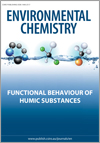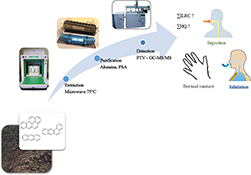Environmental context. Dimethyl polysulfides are malodorous compounds formed from decomposing algal matter. The decomposition of dimethylpolysulfides with 3–5 sulfur atoms was studied in aqueous solution under dark, oxygenated conditions and compared with observations of natural systems. The half-lives of dimethyl tri- and tetrasulfides are very long (176–100 000 years), while the half-life of dimethyl pentasulfide (<2 years) is similar to the observed time of its removal from natural aquatic systems.

Environmental Chemistry
Volume 16 Number 7 2019
Environmental context. The correlation of physicochemical characteristics of humic substances with their function is crucial to our understanding of how environmental pollutants interact with humic substances. We have developed an approach that models emergent functions of fulvic and humic acids depending on sample characteristics. The results will be useful for predicting the sequestration of organic contaminants in soil under various conditions.
EN19073An environmentally friendly method for the determination of polycyclic aromatic hydrocarbons in different soil typologies
 , Estefanía Concha-Graña, Enrica Picariello, Valeria Memoli, Giulia Maisto, Purificación López-Mahía and Soledad Muniategui-Lorenzo
, Estefanía Concha-Graña, Enrica Picariello, Valeria Memoli, Giulia Maisto, Purificación López-Mahía and Soledad Muniategui-Lorenzo

Environmental context. Polycyclic aromatic hydrocarbons (PAHs) are widespread organic pollutants that tend to accumulate in soil. We developed an environmentally friendly analytical method for PAHs to evaluate human health risks associated with their presence in soils. The method is feasible for the analysis of soils with widely varying PAH contamination levels, and is well suited to environmental monitoring studies of relevance to human health.
EN19013Mechanism of surface reactions and dissolution of fluorite surface in an aqueous electrolyte solution
Environmental context. Solubility and dissolution rates of mineral surfaces depend on both the surface properties of the mineral and the composition of the aqueous solution. We investigated the link between the interfacial reactions and dissolution of a fluorite crystal. The study provides a detailed microscopic picture of the dissolution phenomena at the fluorite surface, and the results have wider application to general mineral dissolution processes taking place in the environment.
EN18137Influence of water molecule bridges on sequestration of phenol in soil organic matter of sapric histosol
 , Jiri Kucerik
, Jiri Kucerik  , Daniel Tunega
, Daniel Tunega  , Nadeesha J. Silva
, Nadeesha J. Silva  , Adelia J. A. Aquino
, Adelia J. A. Aquino  and Gabriele E. Schaumann
and Gabriele E. Schaumann 
Environmental context. Immobilisation of organic chemicals in soil organic matter can strongly influence their availability in the environment. We show that the presence of water clusters, called water molecule bridges, hampers the release of organic molecules from soil organic matter. Moreover, water molecule bridges are sensitive to changes in environmental conditions (e.g., temperature or moisture) which affect the release of organic molecules into the environment.
EN19133Detecting and discriminating pyrethroids with chemiresistor sensors
 , Lee J. Hubble
, Lee J. Hubble  , Edith Chow
, Edith Chow  , Andrea Sosa-Pintos, Nereus Patel
, Andrea Sosa-Pintos, Nereus Patel  , Roger Chai and Burkhard Raguse
, Roger Chai and Burkhard Raguse
Environmental context. Regular insecticide treatments on the interior of aircraft impedes the spread of mosquitos and other pests internationally, but border protection agencies lack effective tools to ensure airlines have complied. We report the first use of chemiresistor sensors to detect and identify insecticide residue on an interior aircraft surface. The method could be developed into a tool that helps lower the risk of vector-borne diseases like malaria entering international ports.



